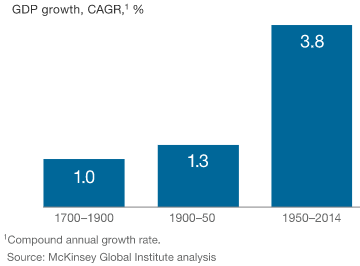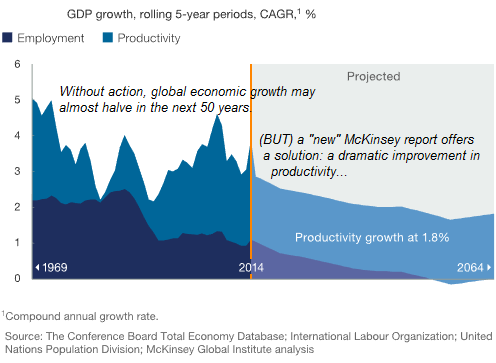Related Categories
Related Articles
Articles
GDP-Growth (Productivity Growth "inside")
1950-2014 & 2014-2064 (!)
Without action, global economic growth may almost halve in the next 50 years. (BUT) a "new" McKinsey Global Institute report offers a solution: a dramatic improvement in productivity.

Over the past 50 years, global economic growth was exceptionally rapid. The world economy expanded sixfold. Average per capita income almost tripled. Hundreds of millions of people were lifted out of poverty.
For the past half century, the twin engines of rapid population growth (expanding the number of workers) and a brisk increase in labor productivity powered the expansion of gross domestic product. Employment and productivity grew at compound annual rates of 1.7 percent and 1.8 percent, respectively, between 1964 and 2014, pushing the output of an average employee 2.4 times higher. Yet this demographic tailwinds weakening and even becoming a headwind in many countries.
Can productivity save the day in an aging world? Even if productivity growth matches its rapid rate during the past half century, the rate of increase in global GDP growth will therefore still fall by 40 percent, to about 2.1 percent a year (see following Exhibit):

Our new normal would then be economic growth slower than it was during the past five years of recovery from the Great Recession and during the energy-crisis decade of 1974 to 1984. Per capita income and living standards, in both the developed and the emerging worlds, will rise more slowly.
Mc Kinsey found out, that productivity growth must drive the expansion of GDP in the longer term. Indeed, it would have to reach 3.3 percent a year - 80 percent faster than its average rate during the past half century - to compensate fully for slower employment growth. Is this possible? Actually, their case studies of found scope to boost annual productivity growth as high as 4 percent, more than enough to counter demographic trends.
The Mc Kinsey-study found that about three-quarters of the potential productivity growth comes from the broader adoption of existing best practices, or catch-up improvements. The remaining one-quarter - counting only what we can foresee-comes from technological, operational, or business innovations that go beyond today's best practices and push the frontier of the world’s GDP potential. Efforts to improve the traditionally weak productivity performance of the large and growing government and healthcare sectors around the world will be particularly important.
The past half century has been a time of extraordinary economic expansion. Yet without significantly boosting the one engine the world economy still has - productivity growth - this period may prove to be a historic anomaly.
While the global economy expanded sixfold in the 50 years from 1964, it may only grow only threefold between 2014 and 2064, if...
Income gains have been, and will continue to be, largely the result of gains in productivity. If the average productivity rate of the past 50 years were to continue, global per capita income would increase by 2.3 times by 2064 compared with the increase of 2.8 times between 1964 and 2014.
The past 50 years were exceptional, but largely because of a fast-growing population. That era is ending. The next phase of growth is likely to be more complex and challenging. Now is the time to have a wide-ranging, clearheaded, and frank discussion about long-term growth that considers not only productivity in the classical sense but every aspect of how to grow smarter, sustainably, and equitably.
Labor's contribution to GDP growth is disappearing, so productivity must pick up the slack !



